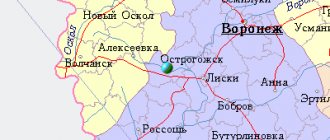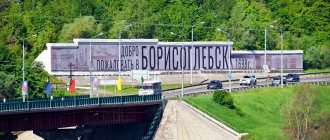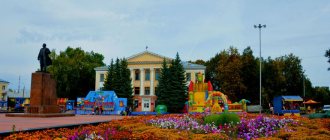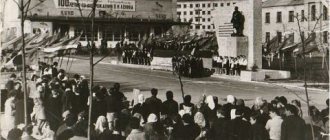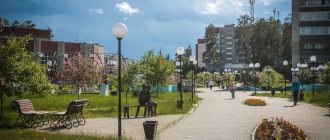Story
Founded in the 17th century. The village of Ertyl, Ertyl yurt.
On September 6, 1698, Voivode Tevyashov conducted a survey of residents of the village of Ertil. Tevyashov wrote about the residents of the village: “Bityutsk residents of the Ertyl yurt of the village of Ertyl.” From among them, he included the names of several: Boris Telegin, Avdey Ivanov, Miron Filatov, Maxim Putimtsov, Foka Kolitvinov. A total of 28 residents of Ertil were interviewed. Their settlers were also Prokofy Belyaev and Semyon Gundorov.
In 1897, a sugar factory was built on the estate of Count A.F. Orlov “Ertilskaya Steppe”. Named after the Ertil River (in the 19th century and earlier - Ertil). Hydronym is considered Turkic, but there is no reliable etymology.
The word “ERTIL” was first mentioned in 1685 (translated from Turkic Ertil is “the place where the tribe lives”). In the 11th-13th centuries, there were Polovtsian encampments on this land. In 1699, by decree of Peter I, peasants from Vladimir, Kostroma and other districts of northern Russia began to be resettled to the Bityug River. Illegally created settlements along Bityug were destroyed, 1,515 households were burned. This is how the first villages appeared: Bityug-Matryonovka, Shchuchye, Old Ertil, etc.
From Empress Catherine II at the end of the 18th century, Count Orlov, Alexey Grigorievich, received a gift of 39,000 acres of land in the Pribituzhye region for his services and officially became known as the “Ertil Steppe”. After his death on December 24, 1807, the lands came into the possession of the only heiress, daughter A. A. Orlova-Chesmenskaya.
In 1832, A. A. Orlova-Chesmenskaya ceded part of her possessions, called the Ertil steppe, to her relative, Count Alexei Fedorovich Orlov. These lands with a total area of 42 thousand dessiatines were located near the Greater Ertil River.
With the death of N.A. Orlov in 1885, his inheritance passed to his sons Alexei[6] and Vladimir[7] Orlov, who found more effective ways to increase wealth. By the end of the 19th century, sugar production had become one of the leading places in the industrial sector of the Voronezh province. Having secured a considerable loan from the State Noble Land Bank, the Orlov brothers organize the construction of a sugar factory. The location for the plant and the village was chosen deliberately. It happened at the intersection of the bank of the clean Big Ertil River and the cattle road. In 1891, construction of a sugar factory began on the estate by 400 peasants from nearby villages. They became his first workers. Construction ended in 1897.
Essentially, the plant was the starting point from which Ertil began. The first building of this enterprise was located on the territory of a modern foundry and mechanical plant. Under Prince Orlov, residential one-story buildings were also built and still remain on Sadovaya Street and Sadovaya Square. And the street itself was then called “Nevsky Prospekt”, was paved with cobblestones and was illuminated in the evenings by electric lanterns. The population of the village was 426 men and 32 women (only single young people were hired). After the death of the prince, the estate passed to V.N. Orlov, he turned out to be the last owner of the sugar factory and farms. V.N. Orlov received the highest permission and in three years built a railway on the Oborona (Mordovo) - Ertil section, and in 1915 traffic along this railway line was opened.
Sugar factory in Ertil, 1916
In 1917, after the start of the revolution, in the main building of the sugar factory, the Bolsheviks Ivan Ivanovich Bakulin and Efim Ivanovich Zimoglyal held a meeting and announced the victory of the October Revolution in Petrograd; they called on the workers to have revolutionary consciousness and fight against the bourgeoisie. On January 31, 1918, the Voronezh provincial congress of sugar industry workers, by its resolution, nationalized the sugar factory. At the same time, the surplus appropriation policy began.
During the civil war, Ertil alternately passed to the whites and then to the reds; the sugar factory was partially destroyed and burned. The railway station was also damaged. The plant was restored in 1926-1928. At the same time, the drying shop of the enterprise was built, and this microdistrict was nicknamed “Drying”. And the “Stroyka” microdistrict was named so because of the construction of a new sugar factory building, which was erected from June 1931 to February 1934 (by the scale of the 1930s, it was one of the largest factories in the Central Black Earth Region). At the same time, a school, kindergarten, nursery and residential buildings appeared there. During the first years of construction, laborers lived in dugouts.
The period from 1929 to 1934 is noted in history as a period of economic and moral decline caused by collectivization and dispossession. In 1932, two large beet-growing state farms were organized: “Krasnoarmeysky” and “Udarnik”. In 1933, a grain collection point was put into operation. The period from 1932 to 1935 was marked by the construction of houses on the first streets of the Novostroika village, the creation of an inter-district oil depot and the Krasny Pishevik industrial market. The village of Ertil acquired the status of a “workers’ village” in 1937. In June 1939, the Ertil Oil Factory was launched.
Beet drying plant on the territory of the current foundry and mechanical plant during the NEP years
A noteworthy milestone in the history of Ertil was the launch of the glycerin (“G-2”) and butter and cheese factories. The brick factory was already producing bricks at that time. At the beginning of the Great Patriotic War (namely in the summer of 1942, when the Ertil region was declared front-line), the glycerin and sugar factories were evacuated to Kazakhstan, but after the war only one returned - the sugar factory.
During the war, the Ertilians donated 210 thousand rubles to the fund for the construction of a tank column. We collected food parcels for the front. Small-caliber mortars were manufactured in the sugar factory workshops; U-2 aircraft engines were repaired on platforms at the Ertil railway station. More than 23 thousand Ertilians fought at the front. On June 23, 1941, the first mobilization of Ertilians into the active army took place. The building of school No. 1 housed a hospital, where the wounded residents of the working-class village were served.
The post-war 1946 is marked in the history of the city of Ertil as a year of drought, crop failure, hunger and poverty. But already in 1947, the labor victories of Ertilian farmers were celebrated, the first Heroes of Socialist Labor appeared and mass awards were held. In 1958, MTS was abolished, and the equipment was sold to collective farms. In May 1959, passenger air service began on the Voronezh - Ertil route.
On February 1, 1963, the workers' village of Ertil was given city status. The workers petitioned the Supreme Soviet of the RSFSR to transform the village of Ertil into the city of Sovetsk. The petition was accepted, but the city retained its previous name.
In the fall of 1963, Ertil football players took second place in the Russian championship.
In 1967, a high-voltage power line came to the area, and Ertil was included in the country's power grid. Until 1967, large enterprises, social and cultural facilities, and residential buildings were serviced by diesel engines. The line was pulled from Borisoglebsk in February. blizzards and frost, the Ertilians came out to the highway all together, knocked off the stuck snow from the wires, manually chiseled the frozen ground under the poles, and helped to tension the wires.
The mechanical plant, which was formed from auto repair shops created in 1949, plays a special role in the history of the city. At first, only car engines were repaired here. And in 1958, by decree of the Voronezh Economic Council, the Ertil machine repair workshops were renamed the Ertil Mechanical Plant. This was the only enterprise that produced equipment for preparing feed for animal farms in our country.
In the late 1960s, the first street in the city was paved. The 1970s and the first half of the 80s saw noticeable changes in the city's economy and culture. The appearance of the city has changed. Enterprises and organizations of great importance for the region were created. In 1973, a forest reclamation station (now a forestry enterprise) was organized. Before its appearance, there were only 1% of forests, after - 3.4%. Through the efforts of this enterprise, an entire residential microdistrict was built, thousands of hectares of forests were planted. A television repeater, a sports complex and stadium, a bath and laundry plant appeared, a local history museum was opened (1974), a market was landscaped, a regional communications center was put into operation, a new grain collection point or elevator appeared (1972), and a new co-op department store was opened in 1973. More than 10 thousand hybrid tea roses were planted in the central square and main street of the city, chestnuts and ornamental shrubs appeared. The city was transformed beyond recognition and was recognized four times as the winner of the All-Russian competition for the improvement of cities and regional centers (1971-1975). More than 40 km of sidewalks and streets of the city have been paved, and a monument to the Ertilians who died during the war has been unveiled. From 1974 to 1979, standard buildings of Ertil schools No. 2 and No. 3 and a training and production plant (TPK) were rebuilt and put into operation. In 1975, the construction of the Voronezh-Ertil asphalt road was completed. In 1976, the Ertilraygas association was organized. In 1979, a hospital complex with 240 beds and a clinic was opened.
The modern administration building (until August 1991 - the district committee of the CPSU) was put into operation in 1982. In October 1994, an important event took place for the city and region - the new Church of the Iveron Icon of the Mother of God in the city of Ertil was consecrated[8]. In 1995, the Book of Memory of the Ertil region was published. In 1997, modern buildings of Sberbank and the tax office were opened.
Ethnographic installation
Over time, many items from the museum collection migrated to other objects of the ethno-village - to a Russian hut with a real stove, to a weaver's house, to a blacksmith's workshop, to a fisherman's hut, to an apiary and to a dugout. You can go into each of these buildings and find out how and what was built in them a hundred or two years ago. Right there on the territory there is an observation tower (the territory of Ertil hundreds of years ago was borderland and was attacked by nomadic tribes) and a real windmill.
Entertainment is provided for guests: wallowing in the hayloft, pillow fights, log swings on which you need to keep your balance, ropes stretched over a pond through which you need to walk without falling into the water. Sometimes newlyweds come to the ethno-village: they have come up with their own romantic adventure here. The bride and groom must cross seven bridges and complete certain tasks - write letters to each other, launch paper boats, hang a castle, and so on.
Chronicle of the city's development
- 1685 - the first mention of Ertil;
- 1897 — completion of the construction of the princes Orlov sugar factory;
- 1915 — start of operation of the Mordovo-Ertil railway line;
- 1921 - burning of a sugar factory by Antonovites;
- 1928 — start of operation of the “Beet Dryer”;
- 1934 — launch of a modern sugar factory;
- 1935 — opening of Ertil secondary school No. 1;
- 1938 — formation of a district with an administrative center in Ertil;
- 1939 — the beginning of publication of the regional newspaper;
- 1958 — organization of a mechanical plant;
- February 1, 1963 - giving Ertil the status of a city;
- 1967 — creation of the Ertil electrical network;
- 1968 — creation of PMK-706;
- 1974 — opening of a museum, a communications center, and secondary school No. 2;
- 1975 — start of movement along the Voronezh-Ertil highway;
- 1979 — opening of a hospital complex;
- 1980 — organization of an experimental mechanical plant;
- 1994 — consecration of the church (temple in honor of the Iveron Icon of the Mother of God);
- 1997 — commissioning of the buildings of Sberbank and the tax service;
- 2003 — opening of the Sokolov school;
- 2004 — launch of a vegetable oil plant;
- 2006 — launch of the gas complex.
Culture, science, education
Currently, there is a local history museum in Ertil, the exhibits of which are constantly being replenished. Its attraction is the work of the artist Vasily Nikolaevich Silin, who donated more than 40 paintings to the museum. In the city of Ertil there is a cinema "Rodina", which shows domestic and foreign films.
Also in Ertil, the Power-metal group “VERSION” began its existence in 2006.
Currently, there are six secondary schools, one vocational school, a music and sports school, a house of pioneers (schoolchildren), a palace of culture, and a city library in Ertil.
Museum of Peasant Life
One of the objects of the “village” is a museum of peasant life, which contains hundreds of exhibits: tools, tools, interior items and everyday life of residents of the Voronezh province. Here you can even find “overseas” machines used by local farmers, for example, a straw cutter manufactured in London at the beginning of the 20th century. But the main value of the museum is the loom, which, despite its considerable age (about 200 years), continues to work. Local craftswomen even wove several rugs on it.
Honorary citizens of Ertil
- Silin, Vasily Nikolaevich. Born in 1918. The front-line artist donated more than 40 canvases to the museum and for a long time maintained close ties with the city, considering it the best place on earth. One of the streets of Ertil is named after him. He was buried in Lipetsk.
- Goleva Ekaterina Ivanovna, born in 1923, native of the village of Shchuchye. Participant of the Great Patriotic War. From 1948 to 1981 she worked as a librarian, then as director of the district library. Headman and active member of the choir of war and labor veterans. The main participant in the work on the Book of Memory of the Ertil region (1995). Lives in Ertil.
- Obryvko Mark Dmitrievich, born in 1909. Design engineer, inventor and innovator, head of the design bureau at a sugar factory - the predecessor of the experimental mechanical plant. Laureate of the State Prize. For his success in creating mechanisms for the sugar industry, in 1966 he was awarded the title of Hero of Socialist Labor. Died in 1999. He was buried in Ertil.
- Belolipetsky Boris Ivanovich, born in 1927. During the years of his work as a chief specialist and then director of a sugar factory (1947-1979), reconstruction and a noticeable increase in labor productivity took place. Under his leadership, the construction of housing, cultural and everyday objects was carried out in the Stroika microdistrict. Died in 2001. He was buried in Ertil.
- Zhukov Ilya Gerasimovich, born in 1935, native of the village of Krivka. He worked as a designer at the Obryvko Design Bureau M.D. From 1972 to 1994 - director of a mechanical plant. These were years of stable development, active housing construction along Truda and Plekhanovskaya streets. Died in 2003. He was buried in Ertil.
- Valikova Alexandra Vladimirovna, born in 1937. Veteran of cultural activities in the area. She devoted about 50 years of her life to the popularization of Russian song. Soloist of the choir of war and labor veterans. Lives in Ertil.
- Zavyalov Alexander Ivanovich, born in 1926. Director of the Sokolov school from 1965 to 1999. Innovative teacher with 49 years of experience, scientist. Through his efforts, a memorial complex near the school and the natural environment, a museum of Russian folk crafts and much more were created. Honored Teacher of Russia. Died in 2001. He was buried in Ertil.
- Shmatov Ivan Fedorovich, born in 1920. From 1951 to 1956 - First Secretary of the Republic of Kazakhstan CPSU. In those years, the district occupied a leading position in the region in the grain industry and milk yield. In 1956 he was awarded a large gold medal of the All-Russian Agricultural Exhibition and a “Victory” car. Lives in Voronezh and maintains active contacts with the city.
- Kondaurov Mitrofan Romanovich, born in 1927. Veteran law enforcement officer, Lieutenant Colonel. From 1970 to 1982 - head of the Ertilsky District Department of Internal Affairs. During these years, the district police department occupied leading positions in the region. A lot of educational work was carried out with the team of employees. Has ten government awards. Lives in Ertil.
- Subbotina Natalya Ivanovna, born in 1940. She began her activities in the Ertil region in 1965 as an accountant-economist of the Ertil Department of Agriculture. From 1972 to 1978 she worked as a manager of the State Bank of the USSR. From 1978 to 1991 she held the position of secretary, and then first secretary of the Republic of Kazakhstan CPSU. From 1966 to 1991 - deputy of the district and one convocation (since 1980) of the regional Councils of People's Deputies, delegate of the XXVI - XXVIII Congresses of the CPSU. Under the leadership of Natalya Ivanovna, the construction of new schools, roads, cultural facilities, etc. was carried out in the area. From 1991 to 1996, she was deputy director of the Krasnoarmeysky state farm. From 2002 to the present, he has been deputy head of the district Veterans Council and secretary of the Ertil branch of the Communist Party of the Russian Federation. The title “Honorary Citizen of Ertil” was awarded in 2003. Lives in Ertil.
- Viktor Fedorovich Zharenko, the first director of the newly formed sports school, made an invaluable contribution to the development of sports (especially artistic gymnastics and basketball).
Sights of the city of Ertil (Voronezh region)
Tourism professionals say that if a weekend trip includes three components (beautiful nature, entertainment and educational parts), then usually all participants in the tour are satisfied!
We recently had a similar trip. We were going to see the famous ethno-village in Ertil, but in the end we stopped at the most picturesque Bityug in those places and looked at a very unusual water tower in the village of Political Department. We also got acquainted with the history of two ancient Voronezh estates. But first things first! An hour’s drive from Voronezh, before entering Ertil, there is an open-air museum “Village of the 17th-19th centuries”. Anyone who is interested in the identity of the Russian people with their patriarchal way of life can come to this village.
At the entrance we were already met by the creator of the village, Honored Farmer of Russia Vladimir Ivanovich Brezhnev. You know, you can always feel it when a person with sparkling eyes and genuine sincerity begins to talk from the threshold about one of the most interesting corners of the Voronezh outback!
Here you immediately embrace the spirit of past centuries, and the numerous peasant utensils and domestic animals that greet you quickly tune you into the “village wave”. And how much is around, and how much is new and unusual for a city dweller... Following the peasant hut, we go to the weaver’s home, to the pottery, the fisherman’s house and even to the mill!
The building that is not entirely traditional for this area is also striking - a hut or the dwelling of a mountaineer peasant. There is also another fairy-tale corner for the little ones, where heroes of folk tales stand around a hut on chicken legs.
Of course, you can separately talk about the museum, and about various entertainments, and about the black bathhouse, about several ponds, about local traditions and customs, but it’s better, as they say, to see for yourself once! Overall, on a five-point scale, the place is clearly excellent!
Vladimir Ivanovich happily took us to the cozy beach on Bityug, where for the first time in all our trips to the Black Earth Region we were lucky enough to smear ourselves with healing blue clay.
We wanted to visit the three giant oaks, but we had to politely refuse the hospitable host, because the second part of the trip lay ahead!
After driving for about an hour along the Tambov highway in the pouring rain, we finally found ourselves in a village with the unusual name Political Department.
It’s hard to say whether it was worth spending so much time on the road to this unique attraction, but expectations did not disappoint!
The leaning water tower has become a real tourist highlight not only of the village, but of the region as a whole. Of course, it is not as old and famous as the famous Pisa, but it’s definitely worth a visit. At least for the sake of photographs!
Happy and rested, on the way back we dropped into two more estates near Voronezh. One of them is the estate with the stud farm of the Tulinovs - Baroness von der Ropp in the village of Khlebnoye. And the second estate of the Veretennikovs - Kiselevs “Otradnoe” in the village of Khrenovoe, Novousmansky district.
And to summarize, at a minimum, everyone liked the trip, and at the maximum, I want to visit here again!
Show on map of Voronezh region
Over the past year, the unremarkable town of Ertil in the Voronezh region has become an object of mass tourism thanks to the open-air ethno-museum built here. Its creator simply calls his creation a “village” in which everyone can get acquainted with the peasant life of the 18th-20th centuries and learn something new about the history of the places where they live.
Leaders of the city of Ertil
- Zamotaeva Natalya Ilinichna (1963-1965) - chairman of the executive committee of the city Council of Workers' Deputies
- Lavrov Vladimir Dmitrievich (1966-1971) - chairman of the executive committee of the city Council of Workers' Deputies
- Filonov Nikolai Nikitovich (1971-1974) - chairman of the executive committee of the city Council of Workers' Deputies
- Golev Ivan Vasilievich (1974-1977) - chairman of the executive committee of the city Council of Workers' Deputies
- Kachurin Valentin Maksimovich (1977-1978) - chairman of the executive committee of the city Council of People's Deputies
- Bakhtin Ivan Ivanovich (1978-1982) - chairman of the executive committee of the city Council of People's Deputies
- Kretinin Nikolai Tikhonovich (1982-1989) - chairman of the executive committee of the city Council of People's Deputies
- Kuznetsov Nikolai Ivanovich (1989-1991) - Chairman of the Executive Committee of the City Council of People's Deputies
- Krylov Vladimir Aleksandrovich (1991-1993) - chairman of the executive committee of the city Council of People's Deputies, head of the city administration
- Kryukov Petr Iosifovich (1993-1998) - head of the city administration, chairman of the city council
- Glushchenko Evdokia Mikhailovna (1998-2002) - head of the city administration, chairman of the City Council
- Prokudin Alexander Valerievich (2002 - present) - head of the city administration, chairman of the City Council
Monuments and landmarks
| № | Name of the monument | Date of origin | Location |
| 1 | Houses No. 4, 5, 7, 12 | around 1895 | Ertil, st. Sadovaya |
| 2 | Residential building "Glagol" (demolished in December 2013) | around 1896 | Ertil, sq. Sadovaya |
| 3 | Sugar factory of the Princes Orlovs (3 buildings) | 1897 | Ertil, st. Labor |
| 4 | Dam of concrete hydraulic structures | 1910 | Ertil town, 100 m north. JSC "ELMZ" |
| 5 | The first building of city school No. 1 | 1935 | Ertil, st. Pervomayskaya |
| 6 | Sculpture “Motherland will never forget her sons” | 1957 | Ertil, near Sokolovskaya school |
| 7 | Sculpture of V. I. Lenin | 1965 | Ertil city, central square |
| 8 | Obelisk "To the Victims of the White Terror of 1920-1921" | 1967 | Ertil, st. Lenin |
| 9 | Sculpture of V. I. Lenin | 1970 | Ertil, near the sugar factory recreation center |
| 10 | Memorial to the fallen Ertilian fellow countrymen during the Second World War with burial | 1975 | Ertil, square near the central square |
| 11 | Memorial plaque in honor of the 200th anniversary of A. S. Pushkin | 1999 | Ertil, on the tax office building, st. Pushkinskaya |
| 12 | Memorial stone “To the Ertil warriors who died in peacetime” | 2000 | Square near the central square of the city |
| 13 | Memorial plaque to E. I. Kabanov - Hero of the Soviet Union | 2000 | On the building of ESOSH No. 1 of the city |
| 14 | Memorial plaque to V. F. Kolbnev - Hero of the Soviet Union | 2000 | At the administrative building of the sugar factory |
| 15 | Memorial plaque to the fallen internationalist soldiers Artemov A.I., Usov A.I., Yablonskikh A.P. | 1989, 2000 | On a memorial stone in the city park |
| Memorial to the fallen Ertilian fellow countrymen during the Second World War with burial | Sculpture of V. I. Lenin | Memorial plaque to the fallen internationalist soldiers Artemov A.I., Usov A.I., Yablonskikh A.P. |
The Ertilsky district is located in the northeast of the Voronezh region, in the south of the forest-steppe zone, in the Oksko-Don plain. It borders in the north with Lipetsk and Tambov regions, in the east with Ternovsky district, in the south with Anninsky, in the west with Paninsky and Verkhnekhava districts. The distance from the regional center to Voronezh is 145 km. Includes 14 municipalities. The administrative center is the city of Ertil .
Area 1457.81 sq. km. Population of Gna in 2010 - 27744 people.
The main reason for the organization of the Ertil district is the established specialization of sugar production in this area and the consolidation and development of the village of Ertil.
The district was organized in December 1938 by allocating part of the land from the Shchuchinsky district of the Voronezh region and the Bolshedobrinsky village council from the territory of the Tambov region. In 1957, its territory expanded to include part of the abolished Tokaj region. On December 12, 1962, the district ceased to exist, having been included in the enlarged Anninsky district.
The Ertil region within its modern borders since January 12, 1965. With the return of status, the Tokai (abolished in 1957) and Shchuchin (abolished in 1962) districts were annexed the Ertilsky district
The district center - Ertil acquired the status of a city on February 1, 1963.
Part of the history of the advancement of the Russian population to the eastern outskirts of Russia is the settlement of the Ertil lands. The first villages along Bityug appeared at the beginning of the 18th century after the resettlement decrees of Peter I. Somewhat later, the territories along the Tokai and Malaya rivers were populated. Within the modern region, the major landowners were the famous favorite of Catherine II, Prince A.G. Orlov-Chesmensky, then his dynastic relatives, the Orlovs. The lands of the eastern part were owned by the Messrs. Kologrivovs, the late General Shmarov and the Dondukovs-Korsakovs, who left a memory of themselves with a man-made oak grove.
The appearance of the city of Ertil is associated with the economic activities of the Orlov princes. Here, at the intersection of the cattle route on the way to Moscow and the Bolshoi Ertil River, a sugar factory was built in 1897, around which a factory village was formed. In June 1906, driven to despair by the lack of land, the peasants of the villages of Pobituzhye rebelled. In the summer of 1920 - spring of 1921, a popular uprising broke out in the region, which was called “Antonovshchina” - after the name of one of the leaders. In the bloody battles near Ertil , near the town of Otrog, and in some villages, hundreds of Red Army soldiers and soldiers of Antonov’s detachments died.
The most important events of the 1930s were: the construction of a modern sugar factory and the village of Novostroika, the organization of the Ertilskaya and Pervomaiskaya MTS.
During the Great Patriotic War, more than 22 thousand Ertilians fought on its fronts. Eight and a half thousand of them did not return from the war.
The economy of the region is represented primarily by agriculture. The industry includes six enterprises - mechanical, dairy, sugar factories, etc.
In terms of climate, the region is somewhat different from other regions of the Voronezh region, since there is a reduced amount of annual precipitation and the lowest temperature in both winter and summer.
The largest rivers are Bityug and Tokai , which belong to the Bityug-Khopyorsky hydrological region. These rivers are characterized by tortuosity, slow flow, and a large number of shoals. The Bityug River receives the drying up rivers Gnilusha, Samovchika, Matryonochka, Panevka, Ertil . Tokai River in its upper reaches practically dries up and forms lakes. Tokai is fed only by Malaya Rechka .
The main forest areas of the region are: Malorechenskaya river dacha , Dondukovskaya dacha near Aleksandrovka, coniferous and mixed forests near the villages of Samovets, Bityug-Matrenovka, Shchuchinsky Sands, Malye Yasyrki and the village of Morozovka. The most common tree species are: pine, aspen, alder, elm, birch, poplar, maple, wild pear, elm species, linden, rowan, viburnum, willow species, ash, many shrubs, and oak. The least common species is oak, but 40-50 years ago this species was the dominant one.
The fauna is represented by wild boars, beavers, roe deer, and moose. Wolves, bobcats, swans, squirrels, many species of shrews and ground squirrels have disappeared
Among the fish, the most “resistant” species remained: pike, perch, bream, crucian carp, roach and rudd.
A dead-end railway line runs through the area, connecting the city of Ertil and the urban-type settlement of Mordovo, Tambov region. By rail, in addition to freight, passenger transportation is also carried out on the Ertil-Elets route, passing through the Gryazi and Lipetsk stations.
From the Central Bus Station of the city of Voronezh, a bus departs on the Voronezh-Zherdevka route, passing through Ertil . From the Left Bank bus station in the city of Voronezh there are direct routes to the city of Ertil, passing through Liman, Panino, Bolshoi Samovets. Bus service is also provided with the city of Lipetsk.
On the territory of the Ertil region there are a large number of mounds and settlements dating back to the Bronze and Neolithic ages; historical and cultural monuments, the main of which are:
Church of the Nativity Ave. Mother of God -1781 (village Rostosh),
Church of Dmitry of Thessalonica - 1800 (Shchuchye village),
Church of Michael the Archangel 1866 p. Malye Yasyrki
Church of Michael the Archangel 1846 p. Cell
Residential house from the 19th century. With. Malye Yasyrki
Merchant house from the 19th century. With. Shchuchye
Zemstvo Hospital n. XX century With. Shchuchye
Shops n. XX century With. Shchuchye
Ertil _
The plant management building where V.F. Kolbnev n. XX century st. Pervomayskaya, 1
school where E.I. Kabanov n. XX century st. Pervomaiskaya, 27
Sugar factory of the Orlovs (3 buildings) from the 19th century. st. Sadovaya
In many settlements of the region there are memorial monuments, monuments of glory, Obelisks, sculptures and graves of soldiers who died during the Second World War (1941-1945).
District website: www.govertil.ru
Notes
- ↑ Territory, population of urban districts, cities and municipal districts of the Voronezh region
- ↑ 1 2 The size of the resident population of the Voronezh region by municipalities as of January 1, 2015. Retrieved April 9, 2015. Archived from the original on April 9, 2015.
- ↑ Answer from Gramota.ru
- ↑ THE USSR. Administrative-territorial division of the union republics on January 1, 1980 / Compiled by V. A. Dudarev, N. A. Evseeva. - M.: Publishing house "Izvestia of the Soviets of People's Deputies of the USSR", 1980. - 702 p. — P. 114.
- ↑ My city
- ↑ Encyclopedia of the Paninsky district of the Voronezh region » Landowners of the Paninsky district. Prince Orlov Alexey Nikolaevich
- ↑ Encyclopedia of the Paninsky district of the Voronezh region » Landowners of the Paninsky district. Prince Orlov Vladimir Nikolaevich
- ↑ Russian Churches Temples of the Central Black Earth Region
- ↑ Censuses of the Russian Empire, USSR, 15 newly independent states
Ertil
(Voronezh region)
OKATO code:
20258501
Founded:
1897
Urban settlement since:
1938
City since:
1963 City of district subordination (Ertilsky district, Voronezh region)
Center:
Ertilsky district
Telephone code (reference phone)
| 47345***** | — |
Deviation from Moscow time, hours:
0
Geographic latitude:
51°50′
Geographic longitude:
40°48′
Altitude above sea level, meters:
140 Sunrise and sunset times in the city of Ertil
Links
- Ertil Information Portal
- Expedition of governor I. I. Tevyashov to the Bityug and Osered rivers in the fall of 1698. Vasilenko D. V.
- Ertil // Encyclopedic Dictionary of Brockhaus and Efron: in 86 volumes (82 volumes and 4 additional). - St. Petersburg, 1890-1907.
| Municipalities of Ertilsky district | ||
| Urban settlement: Ertil Rural settlements: Alexandrovskoe | Bityug-Matrenovskoye | Bolshedobrinskoe | Borshchevo-Peskovskoe | Buravtsovskoe | Morozovskoe | Pervomayskoe | Rostoshinskoe | Samovetskoe | Shchuchinskoe | Shchuchinsko-Peskovskoe | Pervoertilskoe | Yacheyskoe Settlements: Aleksandrovka | Bazhenovka | Begichevo | Bityug-Matrenovka | Bolshaya Dobrinka | Big Samovets | Borshchevo-Peski | Buravtsovka | Vasilyevka | Vvedenka | Veselovka | Vinogradovka | Vladimirovka | Voznesenovka | Revival | Knitting | Rotten | Golevka | Gorokhovka | Muddy | Dzerzhinsky | Dmitrievka | Znamenka | Ivanovka (Ertil settlement) | Ivanovka (Pervomaiskoe settlement) | Israeli | Kolodeevka | Komsomolskoe | Kopyl | Krasinka | Krasnoarmeysky | Malorechensky 1st | Malorechensky 2nd | Malye Yasyrki | Maryevka | Mikhailov | Mikhailovka | Michurinsky | Morozovka | MTF "Voskhod" | Nikolsky | Novogeorgievka | Oktyabrsky | Orlyanovka | Pervo-Ertil | Pervomaisky | Privolny | Prudki | Rostoshi | Sadovsky | Semyonovsky | Sergeevka | Sweetie | Sosnovka | Average Samovets | Old Ertil | Studenovka | Chapaevskoe | Shukavka | Shchuchinsky Sands | Shchuchye | Ertil | Cell | ||
| District centers of the Voronezh region | |||
| Administrative center: Voronezh Anna | Bobrov | Boguchar | Buturlinovka | Upper Mamon | Upper Hawa | Vorobyovka | Gribanovsky | Kalach | Kamenka | Kantemirovka | Kashirskoe | Liski | Nizhnedevitsk | New Usman | Novokhopyorsk | Olkhovatka | Ostrogozhsk | Pavlovsk | Panino | Petropavlovka | Povorino | Podgorensky | Ramon | Repyovka | Rossosh | Semiluki | Talovaya | Ternovka | Khokholsky | Ertil | |||
| Settlements on the Bityug River (from source to mouth) | |
| Novopokrovka | Mordovo | Ertil (on the Ertil tributary) | Anna | Bobrov | Nizhny Kislyai | Losevo | Melguny |



